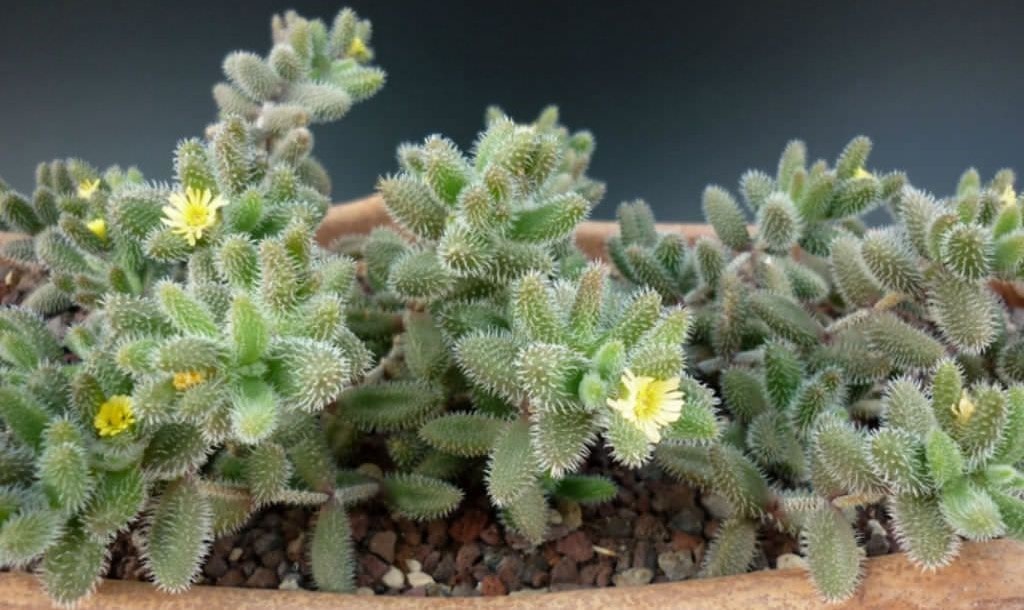Delosperma Echinatum or pickle plant is an easily cultivated succulent, it has thin ascending stems, up to 30 cm high. The leaves are arranged oppositely, cross-shaped, ovoid, or spherical, about 1.5 cm long.
The leaves are bright green, covered with so-called papillae – transparent outgrowths of the skin. Outwardly, it seems that there are bristles on the leaves. The flowers are solitary white or yellowish, about 1.5 cm in diameter. This species is most adapted to indoor conditions.
Table of Contents
Pickle Plant’s Sisters

- Delosperma lehmannii is a low-growing succulent with creeping reddish stems that form wide clumps over time. The leaves are sessile, triangular, glaucous, or light green. The flowers are yellow, large – about 4 cm in diameter, very showy.

- Alpine Delosperma alpinum – dark fleshy leaves, young growths, especially in specimens not growing on the south side, they are green with a reddish base; in adult plants, especially in a sunny place, the leaves are almost plum-colored, the flowers are white.

- Delosperma sutherlandii Delosperma Sutherlandii is another groundcover species, with creeping stems, up to 50 mm long, spear-shaped leaves, about 50 mm long, and 15-20 mm wide, rough. The flowers are large, up to 7 cm in diameter, rich pink, almost purple.
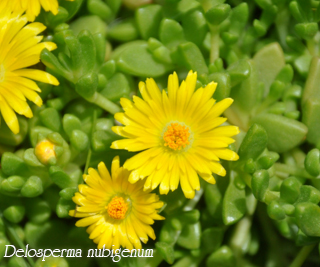
- Delosperma cloudy Delosperma nubigenum – the shoots are short, but form a continuous green carpet plant, up to 5 cm high. The leaves are fleshy, bright green, almost triangular with a convex back side. The flowers are yellow, about 5 cm in diameter.
There are several more types of Delosperma, distinguished by brighter and more abundant flowers, grown in Mediterranean countries as ground cover plants for decorating flower beds and flower beds.
However, these species, as a rule, are not as successful as indoor plants – they are too demanding in terms of care, which is not the same for the pickle plant (Delosperma Echinatum).
Pickle Plant Care Tips
Temperature
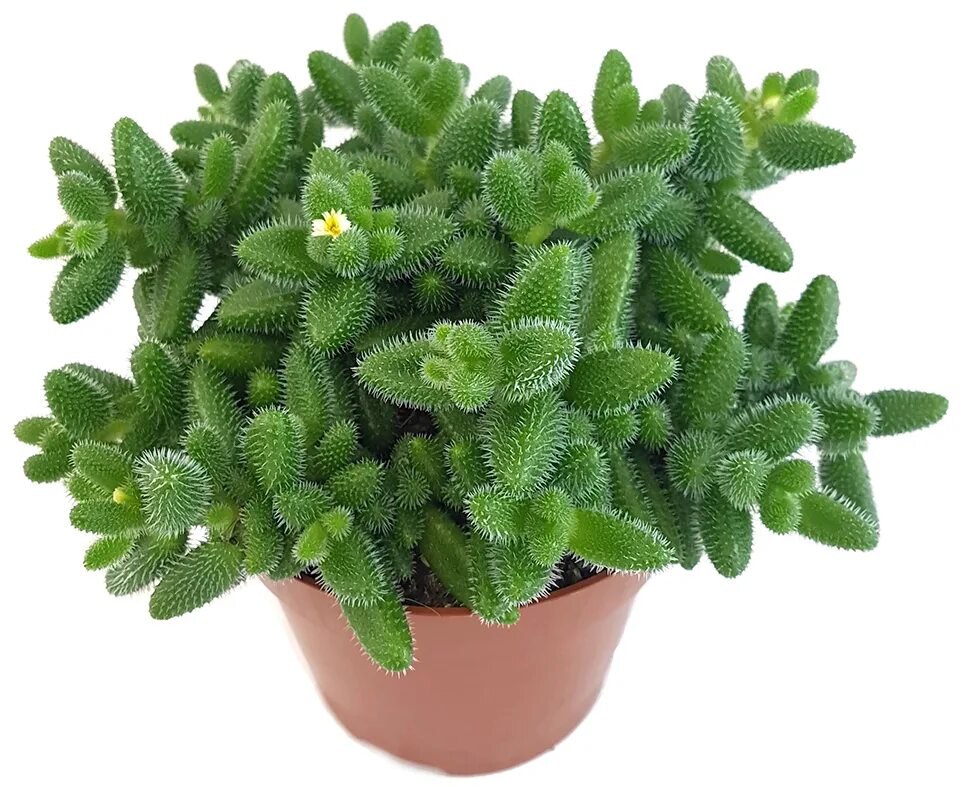
In summer the usual room temperature, although in heat above 28°C the pickle plant should be shaded. In winter, it is advisable to provide a period of rest at a temperature of 10-12°C, at least 8°C, with a dry content.
It is advisable to provide enough fresh air when caring for the pickle plant – it is best on a glazed balcony, where there is light and ventilation without drafts. On the balcony, the pickle plant can stand until October in dry soil.
From spring to autumn it is better to keep the plant outdoors. However, you should be wary of rain, especially if the plant, without having time to dry, comes under the sun’s rays. Even a plant accustomed to the sun can get burned.
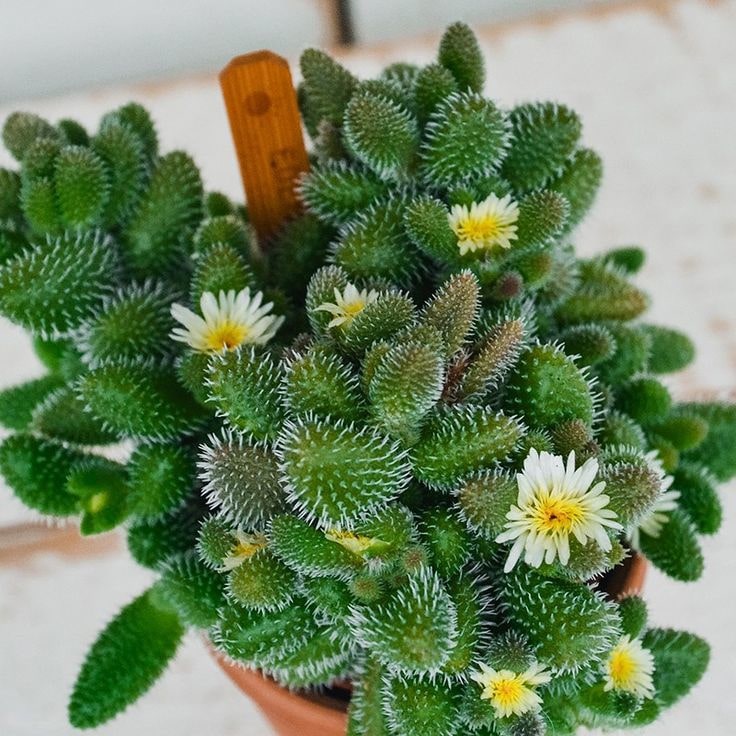
In nature, the pickle plant may grow in open rocky areas or low undergrowth, in a dry climate, but with pronounced daily temperature changes, when overnight the temperature drops by 10-12 degrees and instead of rain, moisture comes with dew.
Lighting
The pickle plant needs full sunlight all the time. If the windows are not sunny, you cannot do it without additional lighting during the heating season in winter.
Use fluorescent (phyto-lamps) or LED – they can be placed at a distance of about 5-7 cm from the leaves.
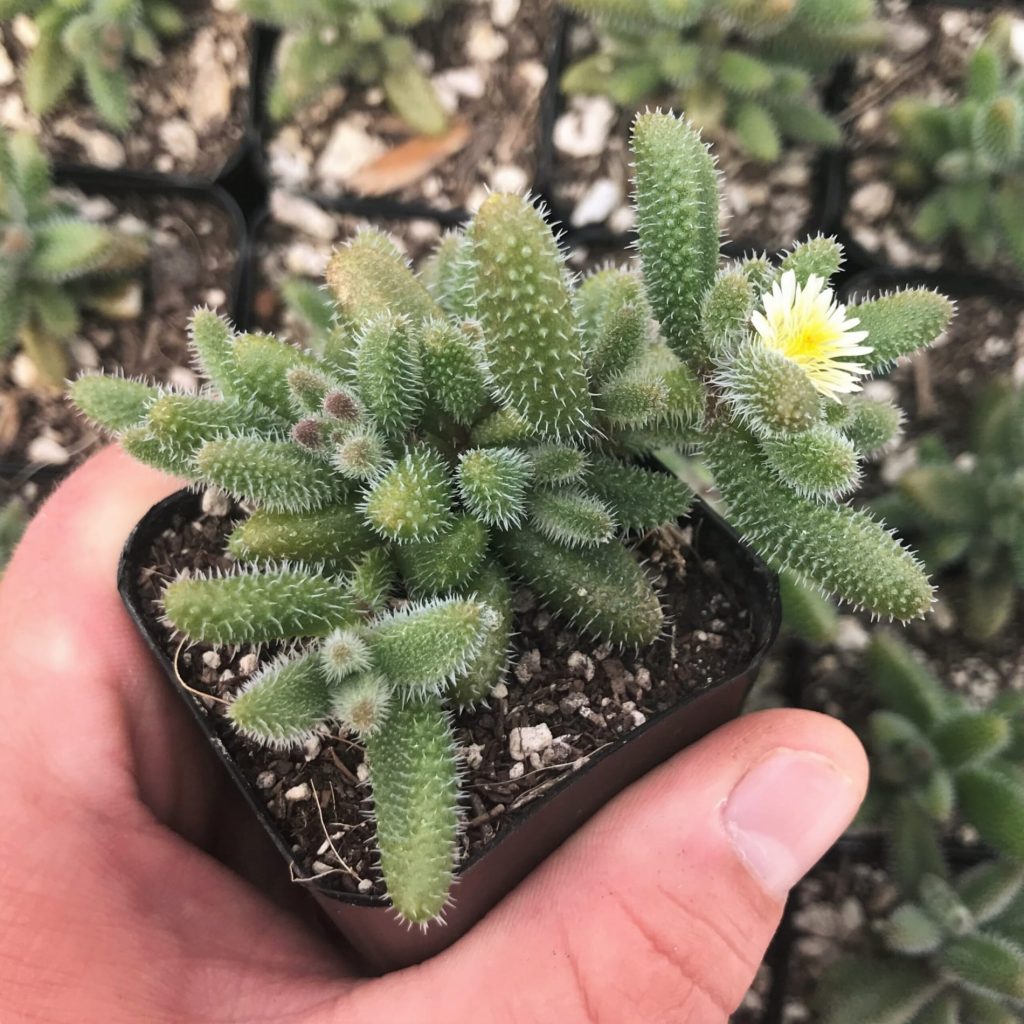
Watering and Air Humidity
moderate watering of the pickle plant during the growing season. Water very carefully if the temperature drops at night or during periods of spring-summer cooling (cloudy and rainy), the pickle plant roots easily rot from excess water.
During the dormant period when kept cold, watering is stopped completely. In many ways, the correctness of watering depends on the structure and quality of the soil.
The pickle plant tolerates dry air well and does not need spraying.
Transplanting Pickle Plant
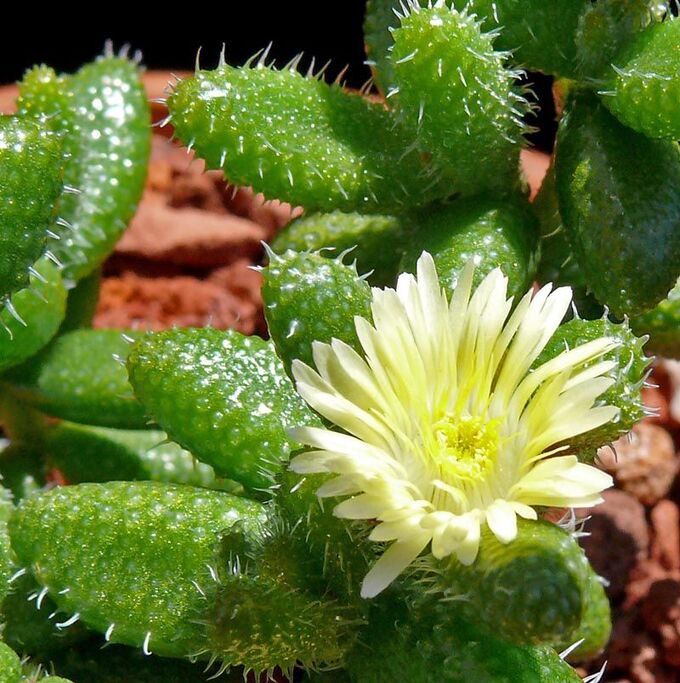
For transplanting the pickle plant, you can use the following soil:
- 1 part turf soil 1/2 part very small pebbles (3-5 mm) and 1/2 part vermiculite.
You can use universal soil from the store but also dilute it with sand, vermiculite, or well-washed zeolite. The correct soil for succulents should absorb water very quickly (in seconds) when watering and dry out very quickly (no longer than 2 days). Succulent pots for planting are suitable for wide and shallow ones; in plastic ones, there are large drainage holes at the bottom or good drainage.

Well-drained soil is one of the keys to the successful cultivation of the pickle plant. In its pure form, peat or store-bought soil is not suitable for growing succulents; loosening components are required – preferably fine gravel or pebbles, quartz sand: for crops, rooted cuttings and leaves about 2-3 mm, for transplanting adults – larger – about 4-5 mm. You can replace them with zeolite granules from cat litter (like non-clumping and insoluble), they need to be rinsed with clean water.
Fertilizer
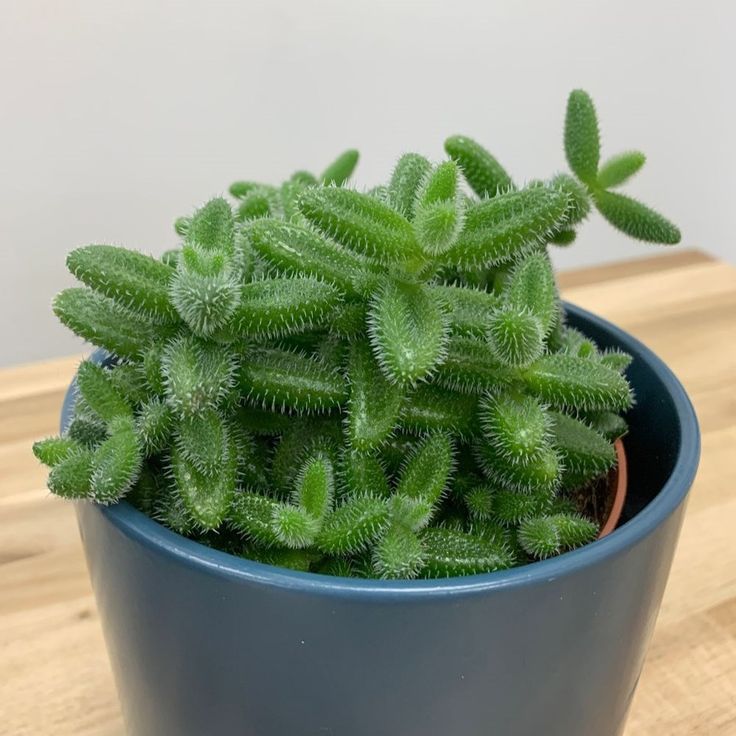
Additional fertilizing should be applied if you have not transplanted the pickle plant into new soil for more than two years. A complex mineral fertilizer is used, diluted in water, in half the dosage specified in the instructions.
Oversaturation has a bad effect on growth and flowering. The pickle plant shoots become very elongated and fewer flowers are produced. The optimal application regime is from mid-spring to mid-summer, with an interval of three weeks.
Fertilizer is taken in a dose of half as much as recommended by the manufacturer or a special cactus fertilizer.
Reproduction

From Cuttings
The easiest and fastest way to get a new pickle plant from a cutting is to cut about 5 cm of a branch from the top of the shoot. You need to remove the leaves from the bottom of the cutting, leaving a piece of bare stem about 2 cm.
Prepare a small pot (about 5 cm in diameter and 7 cm in height), put a clay shard on the bottom, and fill it with soil (peat or leaf soil in half with small pebbles), very moderate humidity – the ground is neither damp nor dry!
Make a hole in the soil with a pencil or pen tip. Insert the cutting and lightly squeeze the soil. Do not water for two days, lightly moisten the soil on the third and then water fairly moderately, but without allowing the substrate to dry out into dust.
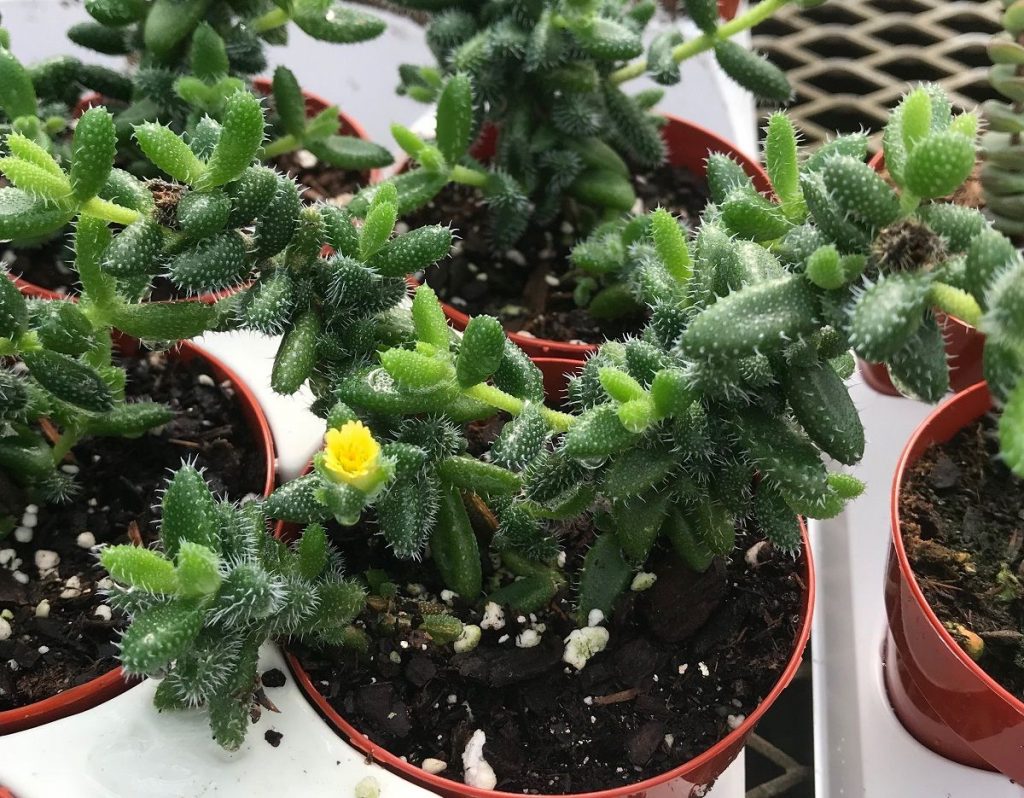
Keep rooted cuttings under light shade, preferably without sudden temperature fluctuations in the first month, while roots are forming.
The appearance of young leaf growth is a sign of successful rooting; the plants can be accustomed to full sunlight.
From Leaves
The pickle plant propagation from leaves is practically no different, except that for rooting you need no pots, but a low and wide bowl. The soil is the same (a mixture of earth and pebbles, 2-4 mm in size); instead of pebbles, you can take very coarse river sand or vermiculite.
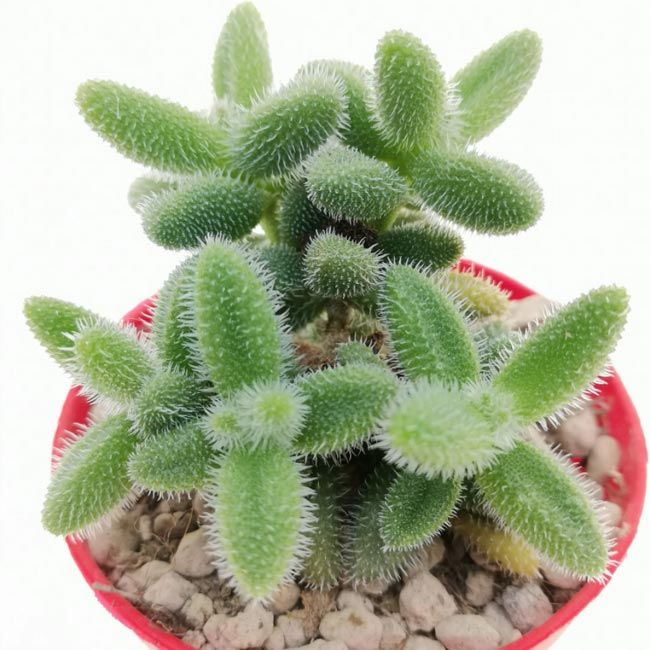
The substrate humidity is moderate, without excessive dampness! Leaves broken from the mother pickle plant should be spread over the surface without digging them in. Place in a bright, warm place. Moisten the soil with a spray bottle once a day. Soon a tiny bunch of new leaves will appear at the base of the leaf.
From Seeds
The pickle plant seeds can be sown at any time if it is possible to provide warmth and light. Sowing in wide bowls under film, in a mixture of universal peat soil and small pebbles in equal parts.
Germinate at a temperature of about 25°C, moistening from a spray bottle. As soon as the seedlings appear, you need to provide enough light (fluorescent or LED lamps are possible).
Diseases and Pests
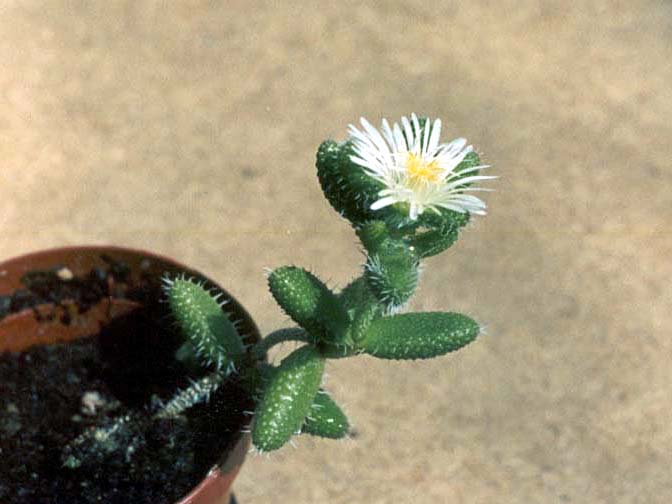
The pickle plant is very resistant to pests and major flower diseases. All problems with its cultivation, as a rule, are associated with errors in choosing a place or caring for the flower. Excessively cool and rainy weather can also be the culprit for rotting.
If a weakened plant is nevertheless attacked by garden pests, you can fight them as follows:
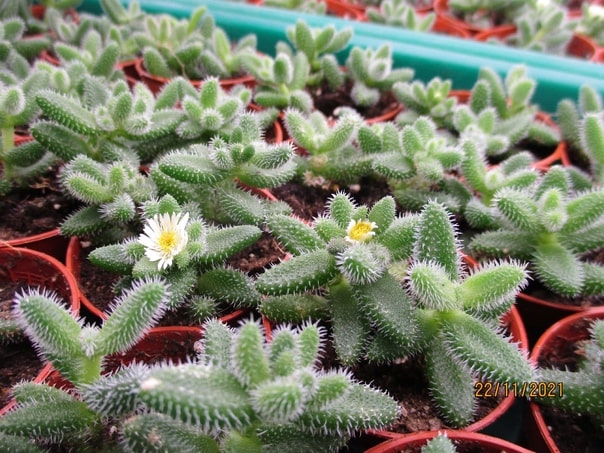
- A soap solution will save you from attacks by small colonies of aphids. One piece of laundry soap is dissolved in 5 liters of hot water. After cooling, the mixture is applied to the bushes.
- The same recipe will help cope with spider mites. Noticeable pests are removed from the bush with a cotton pad soaked in the solution. Cleaned plants are treated with acaricides.
- Specialized preparations containing cypermethrin will help against mealybugs.

